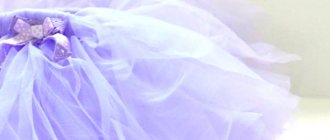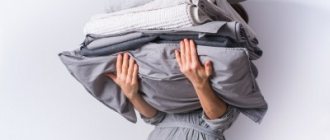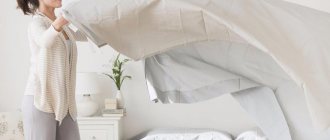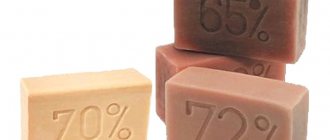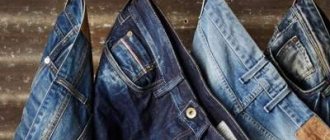Home textiles and some items of clothing sometimes have to be treated with starch to give them rigidity and a clear shape. In modern times this is done much less frequently than, for example, at the end of the last century. Starched items are much less susceptible to contamination and have a completely different appearance than simply washed items. Read more about how to starch bed linen, tulle, clothes, using or without a washing machine, in the text of this article.
Starched items look elegant, fresh and festive
What is starching?
Starching involves rinsing fabric made from natural materials in so-called “starch milk” (an aqueous solution of starch). Most often used for bed linen, lace details or clothing.
Read also: How and why the Berlin Wall fell
Thick starched napkins used to be seen in every home
During the starching procedure, a film appears on the material, which protects the fabric from dirt. In the process of further washing the treated fabric, dirt is removed from its surface along with starch, which dissolves in water.
Different types of raw materials are suitable for the starching procedure. The most commonly used starches are wheat, corn or potato starches. Preparing the solution does not require much time and effort. To do this, starch (the amount depends on the type of procedure) is poured with hot water, stirred and filtered to get rid of lumps.
Types of starching:
The practical meaning of starching
What else, besides pleasant sensations, does starching linen give? Starch, penetrating into the fabric fibers, creates an invisible, thin, protective film on the surface. Therefore, products soaked in paste become stronger and almost do not wrinkle.
The protective “starch” layer prevents your sleeping accessories from getting dirty quickly. If you constantly starch your sets, it’s easy to notice that your sheets and pillowcases will become dirty much more slowly.
In addition, it is worth mentioning the improvement in the quality of washing starched items. The protective film instantly dissolves upon contact with water, and all contaminants are washed off from the fabric along with the shell.
Starching additionally gives a whitening effect, which is especially important for light-colored bedding sets.
How to iron and dry starched items
Dry the fabric until it becomes slightly damp, then begin ironing
All fabrics are ironed while still wet, on both sides, but in slightly different ways:
- silk - through smooth fabric;
- tulle - ironed while wet, straightening the folds;
- embroidered products - only on the reverse side;
- lace - through smooth fabric or gauze;
- gauze - iron damp, straighten folds immediately;
- A white school apron is ironed with a warm iron.
If you first add a little salt to the starch solution, the fabrics will not stick to the iron and will acquire a unique shine.
Why do you starch laundry?
You, of course, have seen more than once how clothes are washed at home. They probably noticed that the linen is also starched.
To do this, take a little potato starch and brew it with boiling water. It turns out to be a thick paste. This paste is added to the water in which the laundry is rinsed for the last time.
Why do they do this?
When rinsing laundry, a thin layer of starch more or less evenly covers the entire surface of the fabric. Then, when the laundry dries, the thin crust of starch causes it to become somewhat stiff. Starching linen also helps improve its appearance after ironing. The fact is that under a hot iron, starch dries completely and partially turns into another substance - dextrin. As a result, a shiny crust is formed on the surface of the linen, which gives the fabric a better appearance. As you can see, the simple home operation of washing and starching clothes turns out to be closely related to potatoes. Perhaps this should not be discussed in such detail, but the use of huge amounts of starch in the textile industry is based on the same principles as home washing. Textile factories produce various types of fabrics; and now it turns out that more than half of all starch produced in our country is consumed in these factories. He has three purposes here. It is used to improve the “base” for thickening paints, and most importantly, for finishing fabrics.
Let us explain this in a little more detail. Each fabric consists of two mutually intertwined threads. “Warp” and “weft” are the names of these threads. The “warp” threads run along the fabric, they determine its length, and the “weft” threads run across, they create the width of the piece of fabric. In the weaving process, it is especially important that the “main” threads are smoother and more elastic; then they don’t tear on the loom and weaving goes better. Therefore, the “base” is treated with starch paste or, as weavers say, subjected to sizing. When the fabric is ready, different patterns, flowers, and designs are printed on it. And potato starch appears again. It is added to calico printing inks to make them thicker, so that the design on the fabric is clearer and brighter. But most of all starch is consumed in textile production for the final finishing of cotton, linen and some other fabrics. This operation is called finishing. There are several types of finishing; Among them, the most important is starching. Here, approximately the same thing is repeated as when washing clothes at home. In special cauldrons they cook the “suppret”, which includes starch. Then, when the fabric is completely ready, starch paste is applied to it, either on one side only, or the fabric is soaked through with it. For this purpose, simple devices are used, the so-called “starch pads”. They are arranged as follows: in a trough half filled with paste, a shaft rotates. This shaft, when rotated, picks up the paste. And above it, in close contact with the surface of the shaft, an endless ribbon of fabric moves: At the same time, its lower surface is covered with paste. If you need to soak the fabric deeper with starch paste, another shaft is installed on top of the fabric, which presses it against the first one. After this, the fabric is dried by passing through copper cylinders heated by steam. This treatment of fabric with starch makes it tougher; it acquires a certain “fullness” to the touch.
As you can see, in textile production they use the same property of starch to brew in boiling water and form a sticky thick solution, which we already mentioned when we talked about jelly.
This property is used in many other industries, primarily in bookbinding. After all, the book you are holding in your hands and reading is probably bound with starch paste. Starch produces even better glue if it is treated with strong hydrochloric acid or subjected to strong heat. Then the starch turns into dextrin, which we briefly mentioned when talking about ironing clothes. The best types of glue are made from dextrin. For example, the postage stamps you are familiar with, the envelopes are smeared with dextrin glue. Dextrin is also used in the production of paper, in the manufacture of matches, leather, for gluing plywood, and even in the foundries of machine-building plants. When you need to make a casting, you first prepare a mold from the earth, and then pour molten metal into it. Dextrin binds the molding soil well and allows for good and accurate casting.
The scope and use of potato starch is quite wide. But to an even greater extent they use the products of deep chemical transformation of starch. So far we have given only one example of the chemical processing of starch - the production of dextrin.
If you find an error, please select a piece of text and press Ctrl+Enter.
Does the type of starch matter?
Now on the market there are not only the usual potato ones, but you can also find wheat, rice and others.
The most common and accessible, of course, is potato and it is recommended to use it.
Compared to corn, it copes with the task just as effectively. But before you prepare “jelly” from it, you need to boil it first, 5 minutes will be enough.
But those made from wheat and rice are unlikely to be useful, they have a high cost and are simply not used for such purposes.
There are ready-made products on the market that provide starching for things. Housewives may prefer this method, which will save time.
But here you need to take into account that the effect will not be the same, and the money spent is not always worth it.
Types of starching
Depending on the ratio of water and starch in the paste, starching occurs:
- soft - used for bed linen and clothes for everyday use, for example, summer blouses, dresses (1 tsp starch per liter of water);
- medium hardness - used for men's shirts, napkins, tablecloths, curtains, furniture covers (1 tablespoon of starch per liter of water);
- hard - used for various decorative elements, cuffs and collars on shirts (2 tablespoons of starch per liter of water).
Starching with sugar
Sugar can be used to starch decorative items that are not exposed to water, since sugar becomes sticky when dissolved.
To prepare sugar syrup, take 6 tbsp. sugar and dissolve in 1 liter. water. Place on the fire and heat the solution while stirring constantly. When it boils, remove from the stove.
We dip the product in hot syrup for 20 minutes, then gently squeeze it out, spread it on a flat surface and leave it to dry.
You don’t have to iron a tablecloth or napkin starched with sugar, but if you wish, do it by placing gauze between the iron and the item. This is necessary in order to prevent the appearance of a caramel shade.
Starching with gelatin
To starch fabric for rigidity, you can use a gelatin solution, which is prepared as follows:
- Soak gelatin (1 tbsp) in 50 ml of water at room temperature.
- After about an hour, put the swollen mixture on the stove and heat, stirring. Add 200 ml of water, stir until smooth.
- Dip the decorative item into the gelatin solution for a few seconds, then air dry.
Starching with PVA glue
To starch an openwork napkin with PVA glue, first dilute the glue with warm water in equal proportions and mix until smooth.
Soak the product in the mixture for several minutes and squeeze. Then lay it out on a flat surface on a towel and leave to dry.
By following these rules and watching a video on how to starch fabric, you can easily starch a tablecloth and bed linen. And your beloved husband will be grateful to you for the starched shirts.
Useful tips
It is important to know that not all fabrics can be treated with a paste substance. It is permissible to starch only products made from natural materials: linen, cotton, chintz, calico, satin, cambric. Silk and synthetic underwear cannot be starched.
Let us present to your attention the procedure for preparing a starch solution, which can be used for both automatic and manual washing. Here's a step-by-step guide to action.
- Dissolve starch in cool water. For 1 liter of liquid you need to take a quarter teaspoon of powder.
- Boil water in another saucepan, then carefully pour starch milk into the boiling water in a thin stream, stirring constantly.
- Reduce heat and cook the paste for 5 minutes. The solution should turn out transparent, similar in consistency to regular jelly.
- Cool the starch paste.
- If there are lumps in the composition, strain the sticky liquid using a sieve.
Before starching the laundry, the paste is diluted with ordinary cool water to the required consistency. If you want to give your laundry an interesting blue tint, you can add a little blue to the adhesive solution.
A spoonful of salt added to the paste will give your accessories a glossy shine after ironing. Table salt will also help the products not to freeze when dried in the fresh air in winter. Another useful tip: to prevent starched material from sticking to the sole of the iron, it is better to add 3 drops of turpentine or 0.5 caps of liquid laundry gel to the adhesive composition.
How to starch bed linen?
It is recommended to starch bed linen using a gentle method. Before proceeding with the procedure, wash your clothes in the usual way - by hand or in a washing machine. Next, you should either squeeze the laundry well (this will not be difficult if you use a washing machine) or dry it completely. Thus, the linen must be pre-prepared - it must be clean and fresh so that the starching procedure does not go in vain.
Next, you should prepare the solution. With soft starching, the liquid is prepared as follows:
- Take starch in a ratio of one teaspoon to one liter of water and pour it into a glass,
- Pour cold water over the starch and mix thoroughly until a single liquid is formed without lumps,
- Boil the amount of water required for rinsing (based on which you calculated the amount of starch),
- When the water boils, pour the dissolved starch into it, stirring the water constantly.
- Cool the resulting solution, in which you will rinse your bed linen.
What should the starch liquid be like?
Without lumps, homogeneous, quite dense compared to ordinary water and even a little “slippery”.
The starching procedure itself is incredibly simple: you place clean bed linen (either dry or wet) in the prepared liquid, leave for a couple of minutes, rinse and remove. You shouldn’t twist the product too much after this, just let the linen hang and then wring it out. To make ironing your bedding easier, be sure to shake things before hanging them to dry and never over-dry starched linen.
How to starch bedding and clothes in a washing machine
To starch things in the washing machine, you need to add a small amount of adhesive liquid to the conditioner compartment and start the usual washing cycle
Ready-made starching compositions are sold in household chemical stores - some are applied to the fabric before ironing, others during washing. Starching bedding and linen in the washing machine is as easy as shelling pears:
- to begin with, prepare a “soft” starch solution according to the above-described scheme;
- the composition is poured into the engine compartment for the air conditioner;
- The washing machine toggle switch is set to rinse mode;
- after the process is completed, the laundry is taken out, shaken, and dried;
- The machine is wiped from the inside and ventilated.
When starching in a washing machine, special synthetic liquids are often used, for example, based on polyvinyl acetate, which cope with the task no worse. Additionally, you should not use any conditioners.
A starch agent that is added directly during washing
To starch clothes and table linen made from various types of fabric, a solution of the required composition and concentration is prepared and poured into the machine as described above.
Basic methods
You can use various methods of applying the solution to things. The result will depend on the chosen technique.
Manually
The manual method of processing things implies the following principle of action:
- clothes are washed using the usual method with washing powder;
- a solution is prepared, depending on the size of the clothing, and poured into a basin;
- the item is soaked in the solution;
- Wring out the item and hang it to dry.
In order for the clothes to get the required shape, you should iron the damp fabric with an iron.
Soak
Used for small items, most often collars and cuffs. Starch dissolves in warm water in a proportion of 2 tablespoons per liter of water. The fabric is lowered and left for 2-3 hours, after which it is ironed while wet.
Application by brush
This method is used if you need to starch a collar or other piece of clothing separately. First, you need to dilute the concentrated composition, lay out the washed clothes on a flat surface and apply the solution evenly with a brush. After which the item is dried and ironed using the usual method.
Starch agent
It doesn’t matter what starch you use when preparing the solution for processing, both corn and potato powder will do. The paste cooks equally well in both cases. Here you should be guided by what product is in the kitchen.
Potato starch quickly dissolves in cool water, immediately thickens when steamed with boiling water, and has a crystal white hue. Sometimes the cooked paste gives off a pale blue color. Unfortunately, if you make a mistake when preparing the solution, you can turn the fabric yellow, and this is the only disadvantage of potato powder.
When using corn polysaccharide, you should not be afraid of yellow spots appearing on the material. To make a high-quality paste from it, be sure to “simmer” the solution over low heat for 5-10 minutes.
If you don’t have time to prepare starch paste with your own hands, you can buy a store-bought product with a similar operating principle.
The range of compositions is quite wide, these can be washing gels, conditioners with a starching effect, aerosols for treating fabrics. Some chemicals are poured into the washing machine tray, others are diluted in the basin for additional rinsing, and others are used specifically before ironing. Instructions for use should be found on the product packaging.
The process of starching bed linen does not require excessive effort; any housewife can prepare the paste. But the sheets, duvet covers and pillowcases will remain fresh longer and literally “squeak” with cleanliness. This effect is definitely worth the 10-15 minutes spent on processing.
How to starch things from different types of fabric
Knitted fabric is also treated gently, but it should be dried exclusively on a horizontal surface, otherwise the product will stretch and lose its shape. For knitted products, giving them rigidity, it is recommended to treat them with a gelatin mixture:
- pour a large spoonful of gelatin into half a glass of water and heat in a water bath until completely dissolved;
- then add another glass of water;
- the product is impregnated with the resulting solution.
Ready-made gelatin solution - express starching
This composition is also used for lace napkins, textile flowers and other similar decor. Starch is not suitable for processing dark or colored fabrics, as it leaves whitish spots. The following adhesive composition is recommended for such fabrics:
- depending on the purpose of the textile material, soft or hard processing is performed;
- for soft processing, PVA glue is diluted with warm water in a ratio of one to one, for the hard version - in a concentration of two to one;
- The fabric is placed in the solution, after complete soaking, it is removed and wrung out.
You can starch clothes with PVA glue; to do this, you need to dilute it with water.
This method is not suitable for underwear or excessively large items. There is also sugar syrup treatment:
- six to seven tablespoons of sugar are boiled in a liter of water;
- textiles are placed in a hot solution, soaked, and squeezed out;
- there is one drawback - the “sweet” fabric will attract insects.
You can also starch things with ordinary white sugar.
To starch the most delicate silk fabric, a solution of gelatin or silicate glue is suitable - in this case, dilute one spoon per five liters, soak the product, and squeeze it out a little. After processing, silk acquires elasticity and a beautiful shine.
When you need to starch thin and delicate fabric, use a weak solution
Tulle is used for sewing elegant dresses and ballet tutus. It will require a medium-hard starch solution - two teaspoons per liter of water. The product is thoroughly soaked, removed, and straightened.
For stiffness, the petticoat needs two tablespoons of starch per liter of water.
Multi-layer gauze products are processed in the most harsh ways - at least two large spoons of starch and a small spoon of sodium boric salt are added to one liter of water, the product is immersed there, and when it is sufficiently saturated, squeezed out.
You can starch knitted napkins and a school white apron with numerous laces using a medium-hard solution.
Openwork products made from fine yarn are kept in starch liquid for 5-10 minutes
The product is pre-washed by machine or by hand, placed in a starch mixture for twenty minutes, removed, no need to wring out the apron. As an option, a freshly washed apron is simply sprayed with a solution from a spray bottle or blotted with a wet starchy cloth.
The embroidery canvas is starched to simplify the process of embroidering on it. To do this, the textiles are placed in a hard starch solution for about fifteen minutes and wrung out well. The already embroidered fabric is pre-washed and impregnated with a medium-hard composition for no more than fifteen minutes.
To starch expensive fabrics with bright, rich colors and complex textures, it is better to use a ready-made product
Alternative Methods
Among the folk methods of starching, there are recipes that use other substances. They are available in every home and give almost the same effect.
Sugar
This starch agent is used primarily on napkins or lace. Not recommended for use on everyday clothing.
Cooking method:
- Heat 100 ml of water in a small saucepan until warm.
- Dilute 200 g of sugar in it.
- Continue heating over low heat, stirring constantly.
- As soon as the solution begins to boil, remove the container from the stove and allow to cool.
The disadvantages of this substance include its rapid dissolution and the appearance of a sticky coating after getting wet. Outdoors, the “candied” fabric attracts insects.
Important: overcooked syrup acquires a yellow tint, which can negatively affect the color of the material.
Milk
It is used primarily for fixing the shape of openwork napkins.
Cooking method:
- Mix 200 ml of milk and 0.5 tbsp. rice starch.
- Boil another 300 ml of milk and pour in the mixture obtained earlier.
- Let cool.
- Immerse the product in the solution for 20 minutes. Remove, squeeze by hand and lay out to dry.
Gelatin
Great for processing knitted, silk and dark items. Does not leave light streaks. It is better not to use this product for starching laundry. A large amount of the basic substance will be needed, and during sleep the bed may begin to stick, heated by human heat.
Cooking method:
- Add 1 tbsp. granular substance in 1/2 cup of water. Leave to swell. While waiting, stir several times with a spoon.
- Fill the container to the brim with water, wait until the grains swell and become soft.
- Transfer the resulting mixture to a small saucepan and heat over low heat until the gelatin is completely dissolved. Don't let it boil. Apply when it has cooled down a bit.
This product does not have a bleaching effect, so the item being treated must already be cleaned and bleached, if necessary.
PVA glue
To starch woolen items, knitted flowers, openwork and knitwear, you can use glue diluted with water in a ratio of 1:2. Before applying, you should place a film or thick paper under the item.
For silk and organza use silicate glue: dilute 1 tsp. for 5 liters of water. For 200 ml of liquid, 1 drop of the main substance is enough.
What things should not be starched?
The following things should not be starched:
- Underwear. Reduced breathability and ability to absorb moisture reduces the hygienic properties of linen. And it can even cause the development of fungal and bacterial infections.
- Sports and summer clothes. These items are not treated with starch solution for the same reasons as underwear.
- Synthetic items. Synthetic fibers do not change their properties when processing starch, that is, the procedure will be useless.
- Items decorated with embroidery. Embroidery threads may stick together when exposed to starch solution.
